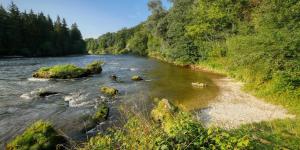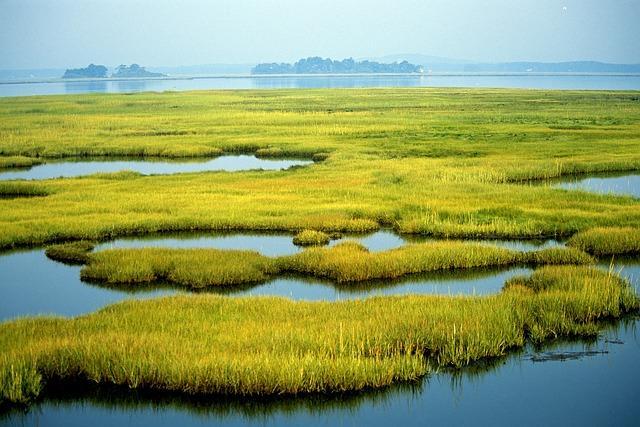What Is a Wetland? - Types and Characteristics


Wetlands are areas of land that are either permanently or seasonally saturated with water. They are found throughout the world and include a variety of habitats such as marshes, swamps, and bogs. Wetlands are important ecosystems that provide numerous benefits to both humans and wildlife. Wetlands also provide a number of essential ecosystem services, including flood control, carbon storage, and recreation.
Continue reading this article from thedailyECO to learn more about what wetlands are, how they are created, and why they are important.
What are wetlands?
Wetlands are areas of land that are saturated with water, either permanently or seasonally. They are characterized by the presence of hydric soils and vegetation that is adapted to wet conditions. Wetlands are found all over the world and include a variety of habitats such as marshes, swamps, bogs, and fens.
There are also anthropogenic wetlands created by humans that artificially retain water, both permanently and temporarily, adapting to environmental conditions.
In the following sections, we will take a closer look at the different types of wetlands and the main characteristics of these ecosystems of great natural richness.

Types of wetlands
There are several types of wetlands, each with its own unique characteristics and ecological functions. Here are some of the main types of wetlands:
- Marshes: are wetlands dominated by grasses and other herbaceous plants. They are typically found in areas with slow-moving or standing water, such as the edges of lakes and rivers. Most marshes are fed by surface water, but some are fed by groundwater. Nutrients are abundant, and the pH is usually neutral, resulting in an abundance of plants and animals.
- Swamps: are wetlands dominated by trees and shrubs. They are typically found in areas of standing water, such as floodplains or along coastal areas. Swamps are characterized by saturated soils during the growing season and standing water at certain times of the year. The highly organic soils of swamps provide a dense, black, nutrient-rich environment for the growth of water-tolerant trees.
- Bogs: Bogs are wetlands characterized by acidic, nutrient-poor soils dominated by mosses and other acid-loving plants. They are typically found in areas with high rainfall and cool temperatures. Peatlands receive all or most of their water from precipitation rather than from runoff, groundwater, or streams.
- Fens: Fens are wetlands similar to bogs, but they receive nutrients from sources other than precipitation: usually from uphill sources by drainage of surrounding mineral soils and by groundwater movement. Fens also differ from bogs because they are less acidic and have higher nutrient content. They are characterized by a variety of wetland plants, including sedges, grasses, and ferns.
These are just a few examples of the different types of wetlands. Each type of wetland performs important ecological functions and is home to a unique variety of plant and animal species.
Do not miss this other article where we explain what inland waters are.

Characteristics of wetlands
Despite the fact that wetlands have different physical, chemical, and biological characteristics depending on their hydrology, soil, and vegetation, there are some characteristics that they all share. Below, we have listed some of them:
- Wetlands are areas that are either permanently or seasonally saturated with water. The presence of water is what distinguishes wetlands from other types of ecosystems.
- Wetlands have soils that are saturated with water, low in oxygen, and rich in organic matter. These soils are usually poorly drained and may consist of peat, clay, or other fine-grained sediments.
- Wetlands are often highly diverse ecosystems that support a wide range of plant and animal species. They are important habitats for many rare and endangered species, as well as migratory birds and other wildlife.
- Wetlands are influenced by their hydrology, which refers to the movement and distribution of water within the ecosystem. The presence of water affects the physical and chemical processes that occur in a wetland.
- Wetlands are delineated by the presence of hydrophilic vegetation. When hydrophilic vegetation is replaced by non-hydrophilic plants, this may indicate that the wetland ecosystem is transitioning to another type of ecosystem, such as a terrestrial environment.
- Wetlands are considered areas of transition or progressive change between aquatic and terrestrial systems, i.e., mixed ecosystems.
Wetlands are complex ecosystems characterized by a unique set of physical, chemical, and biological features. Understanding these characteristics is essential for effective wetland management and conservation.
You may also be interested in this other article, where we discuss aquatic ecosystems.
Importance of wetlands
Wetlands are among the most valuable ecosystems on Earth, providing a wide range of important ecological and economic benefits.
Firstly, wetlands harbor a high level of biodiversity, including many plant and animal species that are unique to these ecosystems. In fact, wetlands can provide important habitat for endangered or threatened species and can be used for habitat restoration projects.
Furthermore, wetlands act as natural filters, removing pollutants and excess nutrients from water before it enters streams, rivers, and other bodies of water. Not only that, but wetlands store large amounts of carbon in their soils, helping to mitigate the effects of climate change.
Finally, wetlands absorb and store excess water during heavy rains, reducing the risk of flooding downstream. Also, wetland vegetation helps stabilize soil and prevent erosion, which in turn can protect surrounding communities and infrastructure. Not only that, but wetlands can help recharge groundwater and maintain water levels in streams and rivers, which in turn can benefit drinking water supplies.
Despite their importance, wetlands are under threat from human activities such as agriculture, urbanization, and resource extraction.
Do not miss this other article where we talk about the different types of environmental impacts.
If you want to read similar articles to What Is a Wetland? - Types and Characteristics, we recommend you visit our Ecosystems category.
- Castellanos, CA (2005) Wetland ecosystems in Colombia. Industrial University of Santander .
- Rodríguez, H. (10/7/2016) Wetlands of the world seen from space. National Geographic Magazine Spain .
- Schnack, J. et al., (2000) Anthropic wetlands: their contribution to the conservation of biodiversity in the subtropical and pampasic domains of Argentina. Argentine Association of Ecology, Austral Ecology Journal , Volume 10, pp:63-68.







